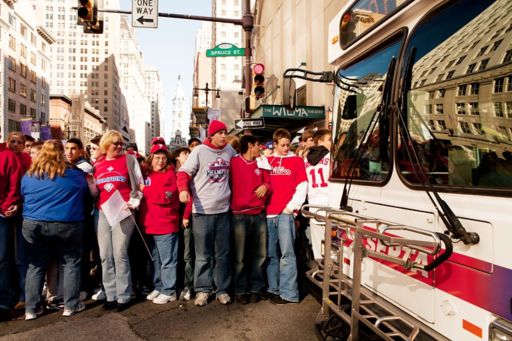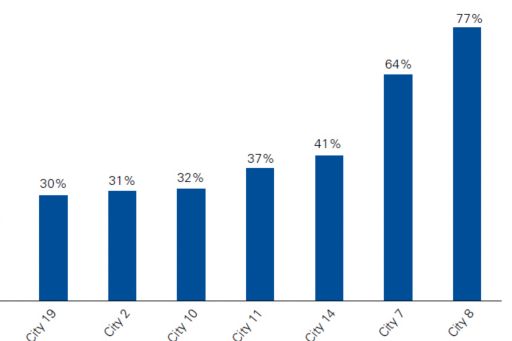Public transit
Public transit
Around the world, cities are pouring millions — sometimes billions — of dollars into developing and improving public transit.

Around the world, cities are pouring millions — sometimes billions — of dollars into developing and improving public transit. But our benchmarking exercise suggests that when it comes to comparing services against other transit authorities more work can be done to collect and compare ridership and route effectiveness indicators. And, as a result, investments may be flowing into ineffective routes, modes and assets.
Defining the service
Transit services — also known as Public Transit — includes a wide variety of modes including bus, streetcar, metro rail and light rail. For this report, the service includes the design, construction, maintenance, repair and operation of transit routes and vehicles and excludes the para transit service.
Topline findings
The average city spends US$1.67 per transit trip (not counting any revenues).
The average cost per kilometer of transit route is US$24.70.
There are no consistently-used measures for effectiveness across cites or transit modes.
Benchmarking analysis
Efficiency
Operating and capital cost per transit trip. This measure combines total public transit operating costs (including internal support service costs and management costs) with the total capital costs and divides the sum by the number of reported transit trips. Percent of transit costs covered by revenue. The measure of how much operating and capital cost is covered by revenue.
Points to consider:
- The cost per transit trip varies from US$0.02 to US$4.70 for 11 cities that were able to provide performance information. Further examination of the low cost may be explained by one city reporting total transit passenger trips but only showing the operating and capital costs for a portion of the transit operations. Other operations may be provided by transit authorities that are separate from the city but operating within its boundaries.
- Few cities reported substantial capital budget amounts in support of transit. Is this because many are struggling to get replacement vehicle funding or are there other reasons that may be contributing to this fact?
- The adjusted mean cost for transit is approximately US$1.70 per trip. This seems low but may be influenced by the currency conversion rates in respective countries, the cost of living in different countries, and a multitude of other factors. Variances may be explained by the passenger count information. Some cities are not entirely sure about the actual count of passengers as many passengers may use transit passes instead of individual tickets/tokens for their transit trip. Furthermore, transit passengers may double count a single passenger who may take multiple transit rides in the course of their commute.
- More and more cities are trying to increase transit ridership. Mature, developed cities have invested considerably in their transit network and provide a variety of transit vehicle options, while less mature, developing cities are struggling to expand their transit network, especially when it comes to light rail and metro options. Further still there are mega cities that struggle to meet transit demand resulting in gray and black market service providers popping into the picture.
- Subsequent studies should focus on distinguishing costs between types of transit vehicles (e.g. buses, light rail, trams, metros, etc.). Future surveys may also reach out to transit associations that may operate in specific countries or regions to increase participation rates and to standardize on metrics that are readily available.
Operating and capital cost per transit trip (US$)

Percent of transit costs covered by revenue
- For the 10 cities that provided costs and revenue, the percentage of costs covered by fees ranges from a low of 3 percent to a high of 77 percent. This wide variation cannot be readily explained.
- The lowest ratio comes from a well-established European city (City 25) while the same can be said for the highest ratio (City 8). Clearly City 8 is in an enviable position where they seek a mere 23 percent top up to cover their costs. Half of the cities that responded appear to realize a cost recovery ratio of between 30–40 percent which means that two thirds of the costs are covered off by funding beyond transit fares and likely from city financial resources or perhaps state supported grants.
- The challenge with achieving full cost recovery is that it penalizes lower income families that desperately need an alternate source of transportation than the car. Conversely, a low cost recovery may inordinately penalize those commuters that don’t wish to use the transit system, particularly if they support bicycle or walk to work commuting patterns.
- Many cities are beginning to wonder what the impact of autonomous vehicles will have on their transit ridership. Will autonomous vehicles reduce transit ridership and increase traffic congestion? Will the cost per transit trip continue to compete with alternative forms of mobility? Regardless of the impact of disruptive technology, cities need to embrace change while continuing to supply affordable transit services.
Percent transit costs covered by revenue

Effectiveness
It was surprising to find that few cities measure the average wait time between vehicles as an indicator of effectiveness. Indeed, with few consistent effectiveness measures being tracked across cities and transit modes, this exercise suggests that most cities are making transit investment and optimization decisions based on unreliable and incomplete data.
Persistent problems
- Improving travel times in the face of increasing road congestion
- Reducing environmental pollution and impact — Increasing ridership as a percentage of total commuter trips
- Expanding capacity to meet growing demand
- Replacing outdated rolling stock and assets.
Common cost factors
- Labor and operational staffing requirements
- Technology and rolling stock
- Fleet upgrades and network improvements
- Energy and oil inputs
- New capital investments and network expansions.
Innovative ideas
- Responding to environmental concerns and targets, many cities — including Dresden — are working to replace existing bus rolling stock with e-busses and hybrid buses.
- Similarly, public transit authorities in Philadelphia are introducing new regenerative breaking electric vehicles to improve fuel efficiency and reduce greenhouse emissions.
- In Lodz, electronic passenger information boards have been installed at bus and trams stops, supported by in-vehicle GPS systems and locating devices.
- Authorities in Sao Paulo have created the Mobility Laboratory (MobiLab) to encourage innovation in public transit through partnerships with academics, entrepreneurs and private enterprises
- To improve the efficiency of road-based transit, authorities in Kazan have implemented new automated traffic control systems and adaptive traffic management practices.
